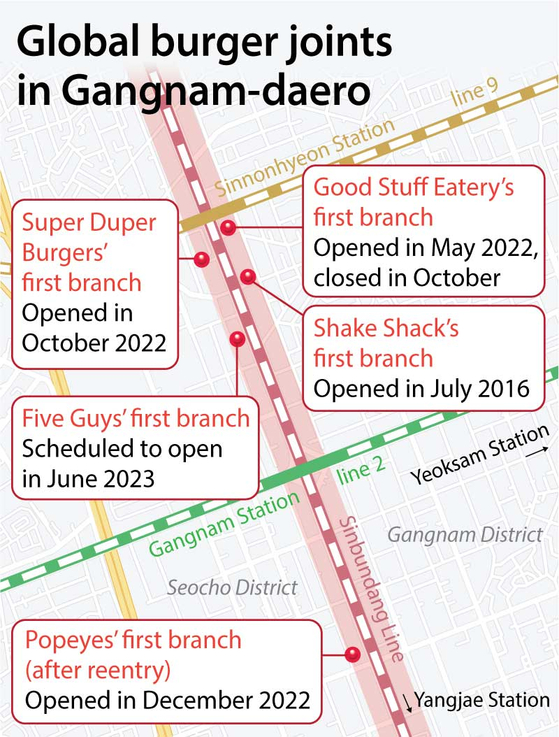Global burger brands say Gangnam or bust
![A rendering of Korea's first Five Guys store set to open near Gangnam Station in June. [HANWHA GALLERIA]](https://koreajoongangdaily.joins.com/data/photo/2023/03/08/0d7a3ece-1c35-47b5-a334-d028ad8c2776.jpg)
A rendering of Korea's first Five Guys store set to open near Gangnam Station in June. [HANWHA GALLERIA]
Popeyes, Shake Shack, Super Duper Burgers, and soon, Five Guys — all four global burger brands made their debuts in Korea in Gangnam District, southern Seoul.
More specifically, all four are located along Gangnam-daero, the main road between Gangnam Station and Sinnonhyeon Station. The road is always bustling with people, a perfect spot to broadcast to domestic consumers that the brands have landed locally.
Hanwha Galleria, the Korean operator of Five Guys, announced on Monday that the first branch will arrive on Gangnam-daero. The store will have two floors and some 150 seats.
Kim Dong-seon, the third son of Hanwha Group Chairman Kim Seung-youn and head of business strategies at Hanwha Solutions’ retail affiliate Galleria, is overseeing the entire project.
It’s Kim’s first project to take charge of.
After it was revealed that Five Guys was coming to Korea, public attention naturally veered toward where the first branch of one of the top three burger joints in the U.S. would be located.
Location candidates included Apgujeong-dong in southern Seoul, where the headquarters of Galleria Department Store is located, or near Gwanghwamun in central Seoul where the first McDonald’s branch was once situated.
“We decided to open Five Guys’ first branch near Gangnam Station where people of multiple age groups frequently gather so that we can showcase the brand to as many consumers as possible,” said Galleria’s spokesperson.
Gangnam-daero is already bustling with premium burger brands. SPC Group brought Shake Shack to Korea and opened its first branch in July 2016; BHC brought San Francisco’s Super Duper Burger last October; and Popeyes reentered Korea last December after a two-year hiatus.
![People wait in line to receive 100 free burgers from Shake Shack’s Gangnam branch in August 2016 as the brand celebrates 100 branches in operation worldwide. [JOONGANG ILBO]](https://koreajoongangdaily.joins.com/data/photo/2023/03/08/86eb6c2e-68be-4d49-b01e-c48021d5b6c6.jpg)
People wait in line to receive 100 free burgers from Shake Shack’s Gangnam branch in August 2016 as the brand celebrates 100 branches in operation worldwide. [JOONGANG ILBO]
Gangnam-daero is attractive to such brands as it fronts some of the highest foot traffic. The road serves as a gathering place for commuters and students and is packed with offices, stores and hagwons, or private cram schools.
The actual sales and the number of stores situated on the road stretching across 1.1 kilometers (0.6 miles) is much higher than other areas, according to real estate company Cushman & Wakefield.
Average monthly sales made from Gangnam stores is some 170 billion won, ($128.7 million). The figure is some 70 billion won for stores near Hongik University in western Seoul, another popular area among students.

d
Sales from Shake Shack’s first branch in Korea were the highest out of all its branches across the globe in the seven months since its launch in Korea, selling 3,000 to 3,500 burgers per day with long queues being a regular sight.
![Customers enjoy their burgers at Super Duper Burgers’ first branch in Korea situated near Gangnam Station.[BHC]](https://koreajoongangdaily.joins.com/data/photo/2023/03/08/8145ca65-a240-437d-8af4-d6e756d3f3b4.jpg)
Customers enjoy their burgers at Super Duper Burgers’ first branch in Korea situated near Gangnam Station.[BHC]
The road is also popular for big franchises due to the availability of first floor premises. These ground-level stores serves as self-advertisements as pedestrians and passengers on public transport or drivers can easily spot them on the road.
“Locations in big-scale neighborhoods like Gangnam and Myeongdong are expensive to rent, but global brands still prefer them because high sales make them worthwhile,” said Nam Shin-goo, head of retail tenant of Cushman & Wakefield.
“However, as opposed to Myeongdong where high foot traffic is usually generated from foreigners, Gangnam is where Koreans frequently visit. Since the surface for pedestrian paths and roads are both extensive, they [stores] can be easily seen by people and has considerable effect on promotion.”
![People wait in line before the official opening of Popeyes’ first branch near Gangnam Station last December. [POPEYES]](https://koreajoongangdaily.joins.com/data/photo/2023/03/08/8b875fcd-fb1b-4761-8824-13cc43c5256b.jpg)
People wait in line before the official opening of Popeyes’ first branch near Gangnam Station last December. [POPEYES]
Popeyes attracted 2,000 customers on the day it opened on Dec. 16, 500 of whom lined-up outside before the store even opened.
On the opening day of Super Duper Burgers, some 1,200 customers visited the store although it was a weekday. On the first weekend of its launch, over 2,000 burgers were sold per day.
But Gangnam-daero does not guarantee success. The high rent was one of the reasons that led to the failure of another American burger brand Good Stuff Eatery. It also opened its doors near Gangnam Station, but shut down last October after just five months.
Experts say that failure is often due to the high exchange rate, as well as the pricey rent.
“The first branch of a global brand is highly meaningful because it’s a testbed to see if it could settle in to the domestic market,” said an anonymous insider from the food service industry. “[The brands] also anticipate the area [Gangnam] to be more vitalized as the Covid-19 pandemic nears the end.”
BY YOO JI-YOEN [lee.jaelim@joongang.co.kr]










with the Korea JoongAng Daily
To write comments, please log in to one of the accounts.
Standards Board Policy (0/250자)